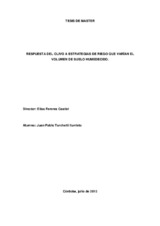Mostrar el registro sencillo del ítem
Respuesta del olivo a estrategias de riego que varían el volumen de suelo humedecido
| dc.contributor.advisor | Fereres Castiel, Elías | |
| dc.contributor.author | Turchetti Iturrieta, Juan Pablo | |
| dc.date.accessioned | 2015-06-09T09:05:54Z | |
| dc.date.available | 2015-06-09T09:05:54Z | |
| dc.date.issued | 2015 | |
| dc.identifier.uri | http://hdl.handle.net/10396/12796 | |
| dc.description | Premio extraordinario de Trabajo Fin de Máster curso 2012=2013.Olivicultura y Elaiotecnia | es_ES |
| dc.description.abstract | El riego parcial alterno de raíces (RPA) es una técnica de riego deficitario desarrollada en la década del noventa en vid. Sus ventajas se han postulado como ahorro de agua y control del crecimiento mientras que se mantienen altas tasas de conductancia estomática (gs) y fotosíntesis (A). Un aspecto que no ha sido evaluado es el efecto de esta técnica sobre la conductancia hídrica del sistema suelo-planta (CHs-p). Se presentan los resultados de un ensayo con árboles de Olea europaea L. cv. Arbequina de tres años con el sistema radical dividido en dos macetas para evaluar el efecto del RPA sobre la CHs-p, gs y A, contrastado con árboles bajo un Riego Parcial Fijo (RPF) y un Riego total (RT), todos ellos regados con la misma cantidad de agua. Los ensayos se realizaron en condiciones de alta y baja demanda evaporativa del ambiente (ETo). También se analizó la respuesta de la CHs-p al cambio de volumen de suelo mojado en RPF y a la desecación del suelo. Los resultados obtenidos mostraron una caída significativa de la CHs-p del 45% en RPA y del 49% en RPF respecto de RT bajo condiciones de alta demanda evaporativa, mientras que la disminución fue del 45% en RPA y del 39% en RPF respecto de RT en baja demanda evaporativa. No se observaron diferencias significativas entre RPA y RPF. Cuando se analizó la CHs-p por unidad de longitud radicular (CHulr) presente en cada maceta, se obtuvieron los mayores valores de CHulr en el tratamiento RPF. No se observaron diferencias significativas de gs y A en RPA respecto de RPF y RT. Por otro lado, no hubo una respuesta significativa de la CHs-p al cambio del volumen bajo riego, lo que fue atribuido a las condiciones de alta humedad y baja ETo. Cuando se analizó la CHs-p bajo un ciclo de desecación, se observó una caída significativa de la CHs-p, gs y A. La conclusión es que el RPA no mejora la CHs-p en olivo. | es_ES |
| dc.description.abstract | The alternate partial root watering (RPA) is a deficit irrigation technique developed on vine in the nineties decade. Its advantages have been postulated as water saving and growth control while maintaining high rates of stomatal conductance (gs) and photosynthesis (A). One aspect that has not been evaluated is the effect of this technique on water conductance of the soil-plant system (CHs-p). We present the results of a trial of three years old Olea europaea L. trees cv. Arbequina with the radically system divided into two pots to appraise the effect of RPA on the CHs-p, gs and A, contrasted with trees under a Fixed Partial Irrigation (RPF), and Total Irrigation (RT); all of them have been irrigated with the same amount of water. The tests were conducted under conditions of high and low ambient evaporative demand (ETo). We also analyzed the response of CHs-p to the volume change in wet soil in RPF and in drying soil process. The results showed a significant drop in CHs-p 45% in RPA and 49% in RPF in respect of RT under high evaporative demand, while the decrease was 45% in RPA and 39% in RPF in erspect of RT in low evaporative demand. No significant differences were observed between RPA and RPF. When analyzing the CHs-p per unit root length (CHulr) present in each pot, the highest CHulr values were obtained in the treatment of RPF. No significant differences were observed in gs and A in RPA respect of RPF and RT. On the other hand, there was no significant response CHs-p to the volume change under irrigation, which was attributed to the conditions of high humidity and low ETo. When analyzing the CHs-p under a drying cycle, there was a significant drop in CHs-p, gs and A. The conclusion is that the RPA does not improve the CHs-p in olive trees | es_ES |
| dc.format.mimetype | application/pdf | es_ES |
| dc.language.iso | spa | es_ES |
| dc.publisher | Universidad de Córdoba | es_ES |
| dc.rights | https://creativecommons.org/licenses/by-nc-nd/4.0/ | es_ES |
| dc.subject | Olivo | es_ES |
| dc.subject | Olea europaea L. | es_ES |
| dc.subject | Riego parcial alterno de raíces (RPA ) | es_ES |
| dc.subject | Conductancia hídrica | es_ES |
| dc.subject | Riego Parcial Fijo (RPF ) | es_ES |
| dc.title | Respuesta del olivo a estrategias de riego que varían el volumen de suelo humedecido | es_ES |
| dc.type | info:eu-repo/semantics/masterThesis | es_ES |
| dc.rights.accessRights | info:eu-repo/semantics/openAccess | es_ES |

